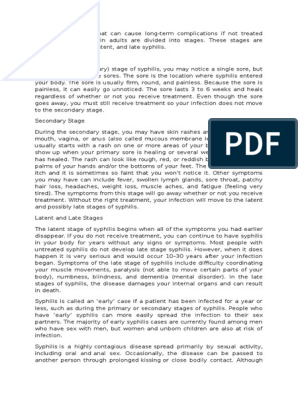0% found this document useful (0 votes)
21 views7 pages23.0601.0038 - Yuliana Lestari
The document discusses syphilis as a sexually transmitted disease that poses significant risks during pregnancy and childbirth, including potential complications for both the mother and baby. It outlines the stages of syphilis, symptoms, diagnosis, and treatment options, emphasizing the importance of early detection and management to prevent transmission and adverse outcomes. Additionally, it highlights the impact of low birth weight in infants and the factors contributing to this condition, linking it to maternal health and syphilis infection.
Uploaded by
yulianalestariulinnuha123Copyright
© © All Rights Reserved
We take content rights seriously. If you suspect this is your content, claim it here.
Available Formats
Download as DOCX, PDF, TXT or read online on Scribd
0% found this document useful (0 votes)
21 views7 pages23.0601.0038 - Yuliana Lestari
The document discusses syphilis as a sexually transmitted disease that poses significant risks during pregnancy and childbirth, including potential complications for both the mother and baby. It outlines the stages of syphilis, symptoms, diagnosis, and treatment options, emphasizing the importance of early detection and management to prevent transmission and adverse outcomes. Additionally, it highlights the impact of low birth weight in infants and the factors contributing to this condition, linking it to maternal health and syphilis infection.
Uploaded by
yulianalestariulinnuha123Copyright
© © All Rights Reserved
We take content rights seriously. If you suspect this is your content, claim it here.
Available Formats
Download as DOCX, PDF, TXT or read online on Scribd
/ 7























































































